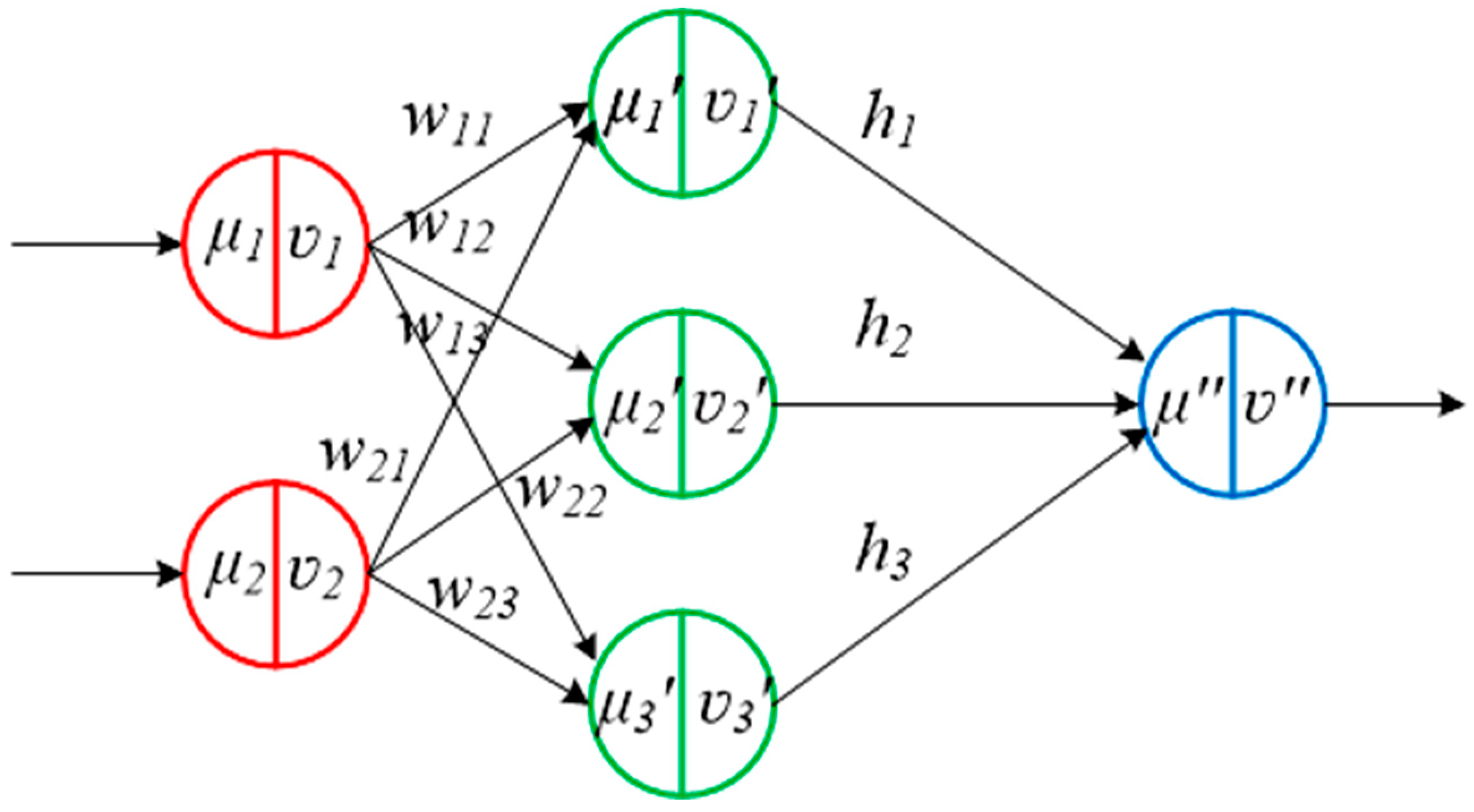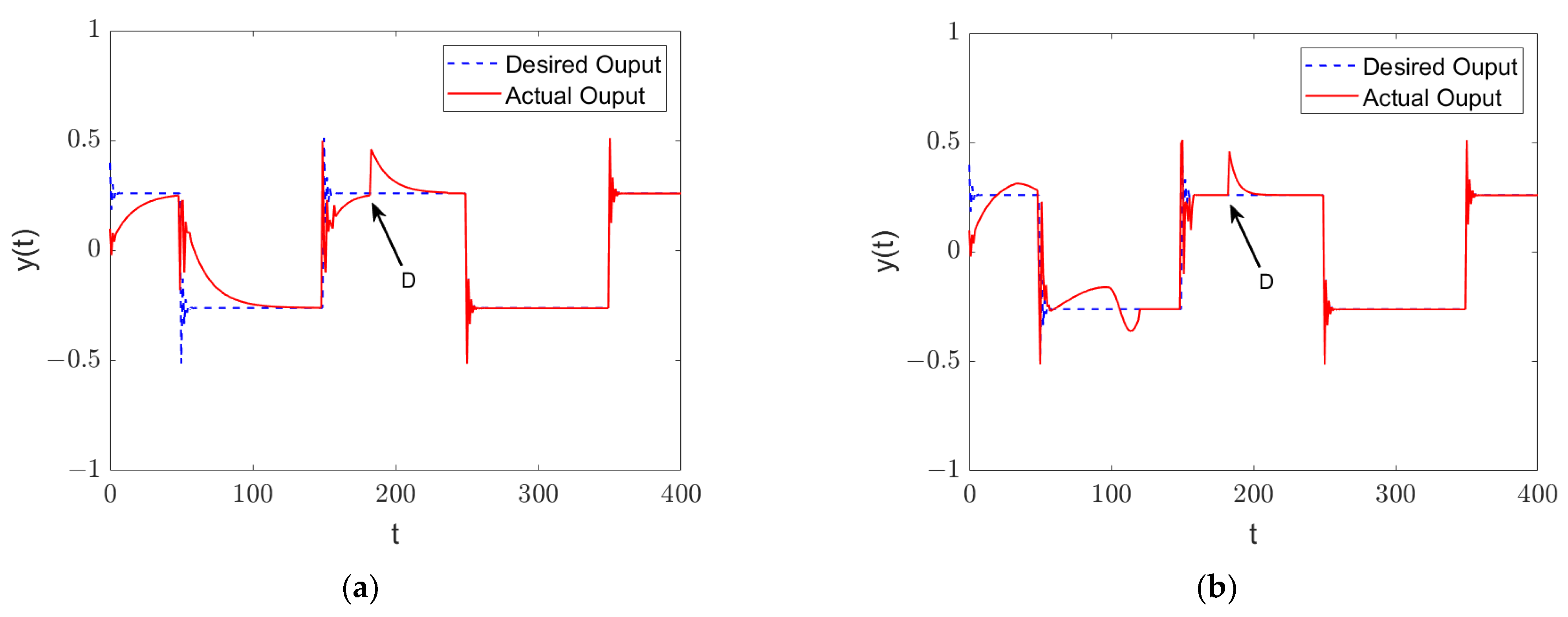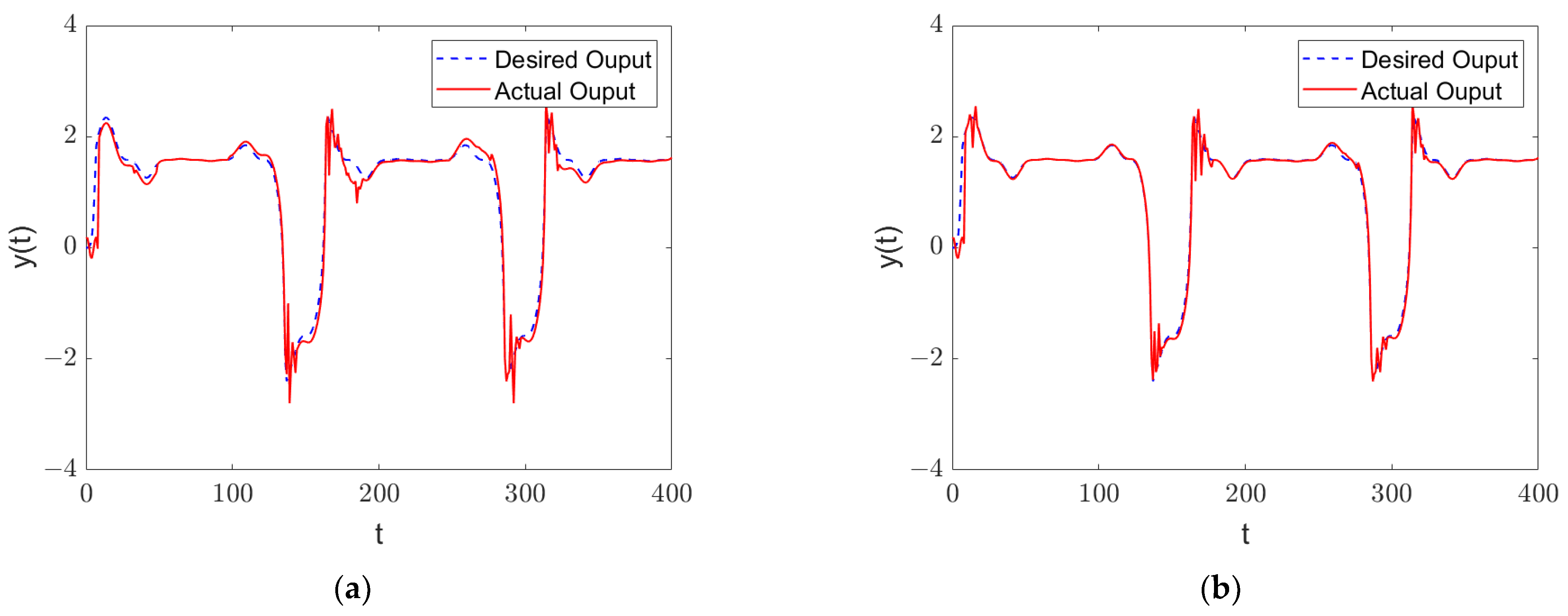Improving Model-Free Control Algorithms Based on Data-Driven and Model-Driven Approaches: A Research Study
Abstract
1. Introduction
- (i)
- Diverging from the conventional NN PID control methods, the control strategy proposed in this paper allows for the online refinement of the weight adjustment mode in PID neural networks. This feature proves advantageous for achieving online optimization, identification, and control of the system.
- (ii)
- Unlike traditional single-innovation feedback, the NN PID control proposed in this paper harnesses the multi-information theory, leveraging historical data to enhance learning efficiency. As a result, the controller exhibits rapid convergence and excellent generalization performance.
- (iii)
- The proposed scheme is validated through rigorous derivation and stability analysis, establishing its applicability. Furthermore, simulation results are presented to provide additional evidence of its effectiveness.
2. Problem Formulation and Preliminaries
2.1. Multi-Innovation Theory
2.2. NN PID Control
3. Control Design and Stability Analysis
3.1. Control Design
3.2. Stability Analysis
4. Simulation
5. Limitations of This Study
6. Conclusions
7. Literature Review
Author Contributions
Funding
Data Availability Statement
Acknowledgments
Conflicts of Interest
References
- Hou, Z.; Chi, R.; Gao, H. An overview of dynamic-linearization-based data-driven control and applications. IEEE Trans. Ind. Electron. 2017, 64, 4076–4090. [Google Scholar] [CrossRef]
- Kou, Z.; Sun, J. Test-based model-free adaptive iterative learning control with strong robustness. Int. J. Syst. Sci. 2023, 54, 1213–1228. [Google Scholar] [CrossRef]
- Hou, Z.; Xiong, S. On model-free adaptive control and its stability analysis. IEEE Trans. Autom. Control 2019, 64, 4555–4569. [Google Scholar] [CrossRef]
- Precup, R.-E.; Roman, R.-C.; Hedrea, E.-L.; Petriu, E.M.; Bojan-Dragos, C.-A. Data-driven model-free sliding mode and fuzzy control with experimental validation. Int. J. Comput. Commun. Control 2020, 16, 4076. [Google Scholar] [CrossRef]
- Dong, N.; Lv, W.; Zhu, S.; Li, D. Anti-noise model-free adaptive control and its application in the circulating fluidized bed boiler. Proc. Inst. Mech. Eng. Part I J. Syst. Control Eng. 2021, 235, 1472–1481. [Google Scholar] [CrossRef]
- Safaei, A.; Mahyuddin, M.N. Adaptive model-free control based on an ultra-local model with model-free parameter estimations for a generic siso system. IEEE Access 2018, 6, 4266–4275. [Google Scholar] [CrossRef]
- Liu, Y.; Peng, F.; Hua, Z.; Liu, C.; Zhao, G. Improved model-free adaptive control of pneumatic gravity compensation system. J. Adv. Comput. Intell. Intell. Inform. 2020, 24, 357–365. [Google Scholar] [CrossRef]
- Roman, R.-C.; Radac, M.-B.; Precup, R.-E. Multi-input-multioutput system experimental validation of model-free control and virtual reference feedback tuning techniques. IET Control Theory Appl. 2016, 10, 1395–1403. [Google Scholar] [CrossRef]
- Prag, K.; Woolway, M.; Celik, T. Toward data-driven optimal control: A systematic review of the landscape. IEEE Access 2022, 10, 32190–32212. [Google Scholar] [CrossRef]
- Wang, X.; Karimi, H.R.; Shen, M.; Liu, D.; Li, L.-W.; Shi, J. Neural network-based event-triggered data-driven control of disturbed nonlinear systems with quantized input. Neural Netw. 2022, 156, 152–159. [Google Scholar] [CrossRef]
- Deng, K.; Li, F.; Yang, C. A new data-driven model-free adaptive control for discrete-time nonlinear systems. IEEE Access 2019, 7, 126224–126233. [Google Scholar] [CrossRef]
- Wang, W.; Rana, J.M. Model-free-adaptive-based data-driven method for three-axis gimbal control. Meas. Control 2020, 53, 1512–1517. [Google Scholar] [CrossRef]
- Wang, X.; Yao, S.; Qu, C.; Wang, Y.; Xu, Z.; Huang, W.; Wang, H. Direct thrust force control of primary permanent magnet linear motor based on improved extended state observer and model-free adaptive predictive control. Actuators 2022, 11, 270. [Google Scholar] [CrossRef]
- Shen, M.; Wang, X.; Park, J.H.; Yi, Y.; Che, W.-W. Extended Disturbance-Observer-Based Data-Driven Control of Networked Nonlinear Systems with Event-Triggered Output. IEEE Trans. Syst. Man Cybern. Syst. 2022, 53, 3129–3140. [Google Scholar] [CrossRef]
- Liu, K.; Lu, P. The design of pid controller of turntable based on bp neural network. Appl. Mech. Mater. 2012, 220–223, 1207–1211. [Google Scholar] [CrossRef]
- Pezeshki, S.; Badalkhani, S.; Javadi, A. Performance analysis of a neuro-PID controller applied to a robot manipulator. Int. J. Adv. Robot. Syst. 2012, 9, 163. [Google Scholar] [CrossRef]
- Tanaka, K.; Oka, M.; Uchibori, A.; Iwata, Y.; Morioka, H. Precise position control of an ultrasonic motor using the PID controller combined with NN. Electr. Eng. Jpn. 2004, 146, 46–54. [Google Scholar] [CrossRef]
- Zhang, L.; Li, S.; Xue, Y.; Zhou, H.; Ren, Z. Neural network PID control for combustion instability. Combust. Theory Model. 2022, 26, 383–398. [Google Scholar] [CrossRef]
- Ding, F.; Chen, T. Performance analysis of multi-innovation gradient type identification methods. Automatica 2007, 43, 1–14. [Google Scholar] [CrossRef]
- Ding, F. Several multi-innovation identification methods. Digit. Signal Process. 2010, 20, 1027–1039. [Google Scholar] [CrossRef]
- Ding, F.; Chen, H.; Li, M. Multi-innovation least squares identification methods based on the auxiliary model for MISO systems. Appl. Math. Comput. 2007, 187, 658–668. [Google Scholar] [CrossRef]
- Han, L.; Ding, F. Identification for multi-rate multi-input systems using the multi-innovation identification theory. Comput. Math. Appl. 2009, 57, 1438–1449. [Google Scholar] [CrossRef]
- Wang, D.; Ding, F. Performance analysis of the auxiliary models based multi-innovation stochastic gradient estimation algorithm for output error systems. Digit. Signal Process. 2010, 20, 750–762. [Google Scholar] [CrossRef]
- Liu, Y.; Xiao, Y.; Zhao, X. Multi-innovation stochastic gradient algorithm for multiple-input single-output systems using the auxiliary model. Appl. Math. Comput. 2009, 215, 1477–1483. [Google Scholar] [CrossRef]
- Xie, L.; Liu, Y.J.; Yang, H.Z.; Ding, F. Modelling and identification for non-uniformly periodically sampled-data systems. IET Control Theory Appl. 2010, 4, 784–794. [Google Scholar] [CrossRef]
- Chen, J.; Zhang, Y.; Ding, R. Auxiliary model based multi-innovation algorithms for multivariable nonlinear systems. Math. Comput. Model. 2010, 52, 1428–1434. [Google Scholar] [CrossRef]
- Han, L.; Ding, F. Parameter estimation for multi-rate multi-input systems using auxiliary model and multi-innovation. J. Syst. Eng. Electron. 2010, 21, 1079–1083. [Google Scholar] [CrossRef][Green Version]
- Qin, P.; Lin, Y.; Chen, M. Improvement of tracking performance in model-free adaptive controller based on multi-innovation and particle swarm optimization. Int. J. Innov. Comput. Inf. Control 2009, 5, 1367–1377. [Google Scholar]
- Bai, R.; Wang, J.; Wang, L.; Ding, F. Design of nn-pid controller based on pso and its fpga implementation. Dyn. Contin. Discret. Impuls. Syst.-Ser. A Math. Anal. 2006, 13, 1307–1314. [Google Scholar]
- Kashihara, K.; Kawada, T.; Uemura, K.; Sugimachi, M.; Sunagawa, K. Adaptive predictive control of arterial blood pressure based on a neural network during acute hypotension. Ann. Biomed. Eng. 2004, 32, 1365–1383. [Google Scholar] [CrossRef]
- Chen, P.; Luo, Y. Analytical fractional-order pid controller design with bode’s ideal cutoff filter for pmsm speed servo system. IEEE Trans. Ind. Electron. 2022, 70, 1783–1793. [Google Scholar] [CrossRef]
- Liu, L.; Zhang, L.; Pan, G.; Zhang, S. Robust yaw control of autonomous underwater vehicle based on fractional-order PID controller. Ocean Eng. 2022, 257, 111493. [Google Scholar] [CrossRef]
- Mirrezapour, S.Z.; Zare, A.; Hallaji, M. A new fractional sliding mode controller based on nonlinear fractional-order proportional integral derivative controller structure to synchronize fractional-order chaotic systems with uncertainty and disturbances. J. Vib. Control 2022, 28, 773–785. [Google Scholar] [CrossRef]
- Rasouli, M.; Zare, A.; Hallaji, M.; Alizadehsani, R. The synchronization of a class of time-delayed chaotic systems using sliding mode control based on a fractional-order nonlinear PID sliding surface and its application in secure communication. Axioms 2022, 11, 738. [Google Scholar] [CrossRef]





| Traditional NN PID Scheme | The Proposed Scheme | |
|---|---|---|
| Convergence time (s) | 200 | 150 |
| Steady-state error | 0.02 | 0.01 |
| Traditional NN PID Scheme | The Proposed Scheme | |
|---|---|---|
| Convergence time (s) | 130 | 80 |
| Steady-state error | 0.5 | 0.1 |
| Paper Title | Key Findings |
|---|---|
| “Analytical Fractional-Order PID Controller Design with Bode’s Ideal Cutoff Filter for PMSM Speed Servo System” [31] | A speed control scheme is introduced, featuring an analytically designed FOPID with Bode’s ideal cutoff filter (BICO). The FOPID controller is devised to follow speed references, and the application of BICO suppression serves to filter high-frequency noise. |
| “Robust yaw control of autonomous underwater vehicle based on fractional-order PID controller” [32] | This study presents a robust design for an FOPID controller implemented in an autonomous underwater vehicle yaw control system. The optimization of supplementary parameters is carried out in accordance with robust design specifications, taking into consideration parameter uncertainties. |
| “A new fractional sliding mode controller based on nonlinear fractional-order proportional integral derivative controller structure to synchronize fractional-order chaotic systems with uncertainty and disturbances” [33] | A new fractional sliding mode controller is presented in this study, based on nonlinear fractional-order proportional integral derivative controllers. The goal is to achieve synchronization among fractional-order chaotic systems characterized by uncertainties and disturbances. |
| “The synchronization of a class of time-delayed chaotic systems using sliding mode control based on a fractional-order nonlinear PID sliding surface and its application in secure communication” [34] | In response to chaotic systems with uncertainties, unknown delays, and external disturbances, a structural approach based on a nonlinear fractional-order PID (NLPID) controller is proposed in this study. This structure constructs a fractional-order sliding surface to formulate the control strategy for the mentioned sliding mode. |
Disclaimer/Publisher’s Note: The statements, opinions and data contained in all publications are solely those of the individual author(s) and contributor(s) and not of MDPI and/or the editor(s). MDPI and/or the editor(s) disclaim responsibility for any injury to people or property resulting from any ideas, methods, instructions or products referred to in the content. |
© 2023 by the authors. Licensee MDPI, Basel, Switzerland. This article is an open access article distributed under the terms and conditions of the Creative Commons Attribution (CC BY) license (https://creativecommons.org/licenses/by/4.0/).
Share and Cite
Guo, Z.; Yang, H. Improving Model-Free Control Algorithms Based on Data-Driven and Model-Driven Approaches: A Research Study. Mathematics 2024, 12, 24. https://doi.org/10.3390/math12010024
Guo Z, Yang H. Improving Model-Free Control Algorithms Based on Data-Driven and Model-Driven Approaches: A Research Study. Mathematics. 2024; 12(1):24. https://doi.org/10.3390/math12010024
Chicago/Turabian StyleGuo, Ziwei, and Huogen Yang. 2024. "Improving Model-Free Control Algorithms Based on Data-Driven and Model-Driven Approaches: A Research Study" Mathematics 12, no. 1: 24. https://doi.org/10.3390/math12010024
APA StyleGuo, Z., & Yang, H. (2024). Improving Model-Free Control Algorithms Based on Data-Driven and Model-Driven Approaches: A Research Study. Mathematics, 12(1), 24. https://doi.org/10.3390/math12010024






